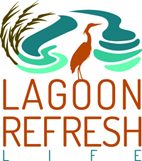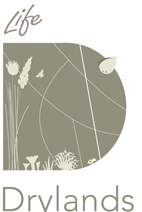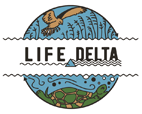Networking
Networking
This page includes links, logos and descriptions of the projects with which LIFE FORESTALL collaborates in networking activities: these consist of an exchange of information, solutions, good practices and results between the projects involved.

LIFE LAGOON REFRESH
LIFE16 NAT/IT/000663
The Life Lagoon Refresh project – Coastal lagoon habitat (1150*) and species recovery by restoring the salt gradient increasing fresh water input – foresees the diversion of a freshwater flow from the Sile river into the Venice Lagoon, necessary for recreation of the typical salt gradient of buffer areas between lagoon and mainland, for restoration of the reedbed habitat, and for improvement of the lagoon environment and its biodiversity.
ISPRA (Italian National Institute for Environmental Protection and Research) is the Partner Leader, whilst the Environmental Direction of Veneto Region, the University of Venice, the Interregional Superintendency for Public Works in Veneto – Trentino Alto Adige – Friuli Venezia Giulia (OOPP), and IPROS Ingegneria Ambientale Srl. are the Association Partners. The project started on September 2017 and it lasts for 5 years.
http://www.lifelagoonrefresh.eu
Project Leader: Dott.ssa Rossella Boscolo Brusà, rossella.boscolo@isprambiente.it
Project Manager: Dott. Andrea Bonometto. andrea.bonometto@isprambiente.it

LIFE DRYLANDS
LIFE18 NAT/IT/000803
The Life Drylands project - Restoration of dry-acidic Continental grasslands and heathlands in Natura 2000 sites in Piemonte and Lombardia.
Habitats targeted by the project include: H2330 - Inland dunes with open Corynephorus and Agrostis grasslands, H4030 - European dry heaths (Po basin heaths), and H6210/6210* -Semi-natural dry grasslands and scrubland facies on calcareous substrates (Festuco-Brometalia) (*important orchid sites) (Central European calcaro-siliceous grasslands (Koelerio-Phleion phleoidis).
Eight Nature 2000 SACs (IT1150001, IT1180027, IT2050005, IT1120010, IT2010010, IT2010012, IT2010013 and IT1120004) are involved in the project.
Specific objectives of the project are: 1) Restoration of the vertical and horizontal structures of the target habitats, 2) Control/reduction of the invasive woody species Robinia pseudoacacia, Prunus serotina, and Ailanthus altissima, those most responsible for biodiversity loss in the target habitats, 3) Improvement of the floristic composition (increase in plant diversity) in the target habitats, 4) Creation of new patches of the target habitats, 5) Production, transfer and replication of guidelines for the management and monitoring of the target habitats on the basis of project results, with the aim of providing management models for an evidence-based conservation, and 6) To make the greater public and stakeholders aware of the importance of Natura 2000 Habitats by promoting the project and its results.
University of Pavia is the Partner Leader. The University of Bologna, the Managing Body of the Protected Areas of the Po piemontese, the Association Lombardy Network of Botanic Gardens, the Lombardy Park of the Ticino Valley, and the Managing Body of the Protected Areas of the Ticino and Lake Maggiore are the Association Partners. The project started on September 2019 and it lasts for 5 years.
Scientific Director (Project Leader): Dott.ssa Silvia Assini, silviapaola.assini@unipv.it
Project Manager: Dott. Stefano Picchi, ste.picchi@gmail.com

LIFE4DELTA_PL
LIFE17 NAT/PL/000018
LIFE4DELTA_PL - Renaturalisation of inland delta of Nida River
The inland delta of the River Nida, the geomorphological structure unique in the continent, is one of the richest areas of great nature interest in Europe. It wholly coincides with the area that is the subject of interest of the Nida SAC (PLH260003) with an area of 26,515.64 ha and the Nida Valley Special Bird Protection Area (PLB260001) with an area of 19,956.10 ha.
The main subject of the project is to take measures aimed at improving the water conditions of the inland delta of the River Nida (C1), which will contribute to the restoration of unique natural values, within the meaning of the Birds and Habitats Directive for:
- 91E0* Alluvial forests with Alnus glutinosa and Fraxinus excelsior (Alno-Padion, Alnion incanae, Salicion albae) (C2);
- 3150* Natural eutrophic lakes with Magnopotamion or Hydrocharition - type vegetation (C1);
- restoring the proper condition of protection of meadow habitats (C3-C4), including creating optimal habitat conditions for birds, e.g. for A021 Botaurus stellaris, A122 Crex crex, A119 Porzana porzana as well as A031 Ciconia ciconia (C5).
- reconstructing or restoring the population of protected species: 1032 Unio crassus (C7), 4056 Anisus vorticulus (C8), 1188 Bombina bombina and 1166 Triturus cristatus (C10) as well as 1220 Emys orbicularis (C6).
The restoration of the spatial mosaic of ecosystems will also have influence on the improvement of the status of populations of plant and animal species subject to special protection, which live here and are listed in Appendix 2 of the EU Habitat Directive, Appendix 1 of the Birds Directive, the IUCN Red List, the Polish Red Book of Plants and Red List of Animals Threatened with Extinction in Poland.
The significant goal of the project is also to create the gene reserves of plant species typical of the Nida Sanctuary, which are threatened with extinction (C11). The indirect goal is the restoration of pastures (C4), abandoned in the 1980s, which will have influence on maintaining the good condition of meadow habitats and animal species living there, for many years, enable us to create new jobs and restore cultural patterns related to pasturing (C4).
The additional goal of the project is to activate the local community in terms of increasing ecological awareness related to the threat of and need to protect one of the most precious ecosystems of the Ponidzie region, as well as education addressed to a large group of recipients (E2).
Coordinating Beneficiary:
The Complex of Swietokrzyskie and Nida River Landscape Parks;
Co beneficiaries:
- The Institute of Nature Conservation of the Polish Academy of Sciencies in Krakow;
- National Forest - Forest District Pinczow;
- The University of Agriculture in Krakow.

LIFE BRENTA 2030
LIFE18 NAT/IT/000756
LIFE Brenta 2030 - PROMOTING GOOD GOVERNANCE AND INNOVATIVE FINANCING SCHEMES FOR BIODIVERSITY AND WATER CONSERVATION OF BRENTA RIVER
https://www.etifor.com/en/portfolio/life-brenta-2030/

LIFE PRIMED
LIFE17 NAT/GR/000511
LIFE PRIMED - Restoration, management and valorisation of PRIority habitats of MEDiterranean coastal areas
Project co-financed by the European Commission under the LIFE programme. The main aim of LIFE PRIMED is to improve the conservation status of habitats and species in the Nestos Delta (SCI GR1150010) and Palo Laziale woods (SCIIT6030022), Natura 2000 sites in Greece and Italy, respectively. Both the areas area featured by transitional small wetlands and coastal forests among the most degraded and threatened ecosystems in the EU.
Target Habitat types:
- 91E0* - "Alluvial forests with Alnus glutinosa and Fraxinus excelsior (Alno-Padion, Alnion incanae, Salicion albae)"
- 91M0 - Pannonian-Balkanic turkey oak-sessile oak forests
- 3170* - Mediterranean temporary ponds
- 5230* - Arborescent matorral with Laurus nobilis
Target species:
- Emys orbicularis
- Euplagia quadripunctaria
- Eurotestudo hermanni
- Phasianus colchicus colchicus
https://www.lifeprimed.eu
Christos Georgiadis
Vito Emanuele Cambria
info@lifeprimed.eu

LIFE LA VALBONNE
LIFE18 NAT/FR/000698
The Life La Valbonne project - Restauration of priority habitats and species of Community Interest in the Valbonne military camp.
La Valbonne camp is one of the major lowland dry grassland areas in the region in terms of surface area (1,400 ha) and its rich heritage. 1,131 ha are classified as Natura 2000: 1,124 ha within SIC/ZPS FR8201639/FR8212011 – Steppes de la Valbonne and 7 ha in SIC FR8201638 – Milieux alluviaux et aquatiques du fleuve Rhône, de Jons à Anthon.
The project primarily targets 3 habitats of priority interest : 6210* - Semi-natural dry grasslands and scrubland facies on calcareous substrates (Festuco-Brometalia) (*important orchid sites), 6120* - Xeric sand calcareous grasslands and 91E0* - Alluvial forests with Alnus glutinosa and Fraxinus excelsior ; as well as 2 habitats of Community interest (3140*-Hard oligo-mesotrophic waters with benthic vegetation of Chara spp and 3260*-Water courses of plain to mountain levels with Ranunculion fluitantis and Callitricho-Batrachion vegetation.
It also targets 2 priority species of birds (Tetrax tetrax and Falco vespertinus), and 22 species of Community interest (including species of birds, molluscs, odonates and bats).
Project objectives are : 1)The restoration of 700 ha of habitats of priority grassland and long-term conservation of 1,000 ha of priority grassland habitats (6210* and 6120*), with an elimination of invasive species; 2) The return of *Tetrax tetrax to the continental zone with reintroduction and nesting on the military site, in implementing specific PNA (national action plan); 3) The restoration of all of the wetlands (91E0* and 7210*) on the Natura 2000 site, with the elimination of invasive species; 4) An increase or a stabilisation of the presence of 22 species of Community interest; 5) An integrated management system for military and hunting activity must be established according to ecological priorities. This management system will allow the full scope of the project's actions to be maintained after-Life; 6) The appropriation of the challenges and the importance of the Natura 2000 network by the military, hunters and the local population. This project will disseminate in France and UE.
The Life La Valbonne project is coordinated by the French Ministry of Armed Forces (Ministère des Armées), in association with the Conservatory of Natural Spaces of Rhône-Alpes (Conservatoire d’espaces naturel Rhône-Alpes) and the Departmental Federation of Hunters (Fédération départementale des chasseurs de l’Ain).
The project started on September 2019 and it lasts for 7 years.
https://www.lifeterrainsmilitaires.fr/life-la-valbonne
Project Leader: Serge PAYAN, serge.payan@intradef.gouv.fr

LIFE GESTIRE 2020
LIFE14 IPE IT 018GESTIRE2020
LIFE GESTIRE2020 is an experimental, innovative and integrated project for the conservation of biodiversity in Lombardy, co-financed by the European Commission under the LIFE + Program. LIFE GESTIRE 2020 intends to implement an integrated management of the Lombardy Natura 2000 Network in 6 lines of action: Improving governance through the consolidation of the knowledge and skills of those who work in the field of nature conservation in Lombardy. Implement concrete interventions for the conservation of habitats and plant species. Implement concrete actions for the protection of animal species. Prevent and counter the spread of invasive alien species. Monitor the conservation status of particularly protected habitats and species. Increase ecological connections, to better connect protected areas and allow animal and plant species to move. The project started on January 1st 2016 and has a duration of 8 years.
https://naturachevale.it/il-progetto/life-gestire-2020/
Project Manager: Andrea Agapito, Fondazione WWF Italia


